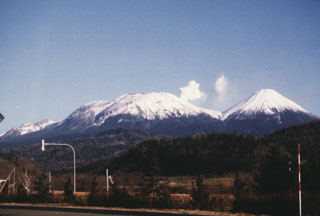Report on Akan (Japan) — March 1982
Scientific Event Alert Network Bulletin, vol. 7, no. 3 (March 1982)
Managing Editor: Lindsay McClelland.
Akan (Japan) Sudden increase in local seismicity
Please cite this report as:
Global Volcanism Program, 1982. Report on Akan (Japan) (McClelland, L., ed.). Scientific Event Alert Network Bulletin, 7:3. Smithsonian Institution. https://doi.org/10.5479/si.GVP.SEAN198203-285070
Akan
Japan
43.384°N, 144.013°E; summit elev. 1499 m
All times are local (unless otherwise noted)
On 21 March a strong (M 6.9) earthquake occurred near Urakawa, off the S coast of Hokkaido and 182 km SW of Akan. Local seismicity at Me-Akan increased after the earthquake, but the JMA has reported that there is no evidence of a causative relationship. The total number of seismic events recorded in March was 411 (table 1). The numbers of recorded seismic events at Me-Akan for 1977-81 are 97, 45, 491, 254, and 194.
Table 1. Number of seismic events recorded at Me-Akan during 19-31 March 1982. Courtesy of JMA.
| Date | Number of Events |
| 19 Mar 1982 | 1 |
| 20 Mar 1982 | 3 |
| 21 Mar 1982 | 9 |
| 22 Mar 1982 | 55 |
| 23 Mar 1982 | 63 |
| 24 Mar 1982 | 26 |
| 25 Mar 1982 | 84 |
| 26 Mar 1982 | 24 |
| 27 Mar 1982 | 30 |
| 28 Mar 1982 | 13 |
| 29 Mar 1982 | 31 |
| 30 Mar 1982 | 50 |
| 31 Mar 1982 | 22 |
Geological Summary. Akan is a 13 x 24 km caldera located immediately SW of Kussharo caldera in eastern Hokkaido. The elongated, irregular outline of the caldera rim reflects its incremental formation during major explosive eruptions from the early to mid-Pleistocene. There are four post-caldera stratovolcanoes, three at the SW end of the caldera and the other on the NE side. Conical Oakandake was frequently active during the Holocene. The 1-km-wide Nakamachineshiri crater of Meakandake was formed during a major pumice-and-scoria eruption about 13,500 years ago. The Meakandake group, composed of nine overlapping cones E of Lake Akan, has produced mild phreatic eruptions since the beginning of the 19th century. The main cone of Meakandake proper has a triple crater at its summit. Although recorded eruptions at Meakandake have consisted of minor phreatic explosions, four major magmatic eruptions with pyroclastic flows have also occurred during the Holocene.
Information Contacts: JMA, Tokyo.

